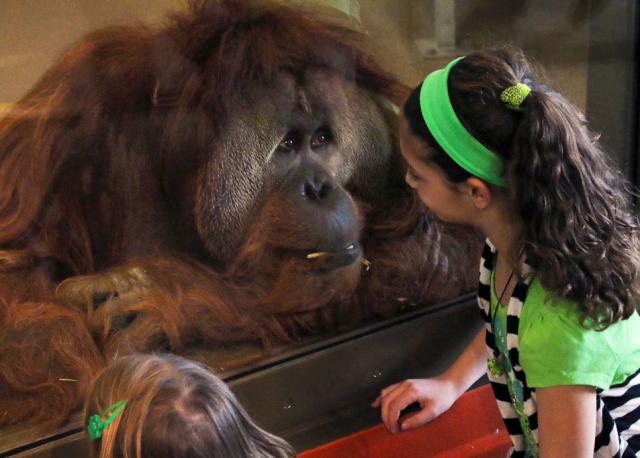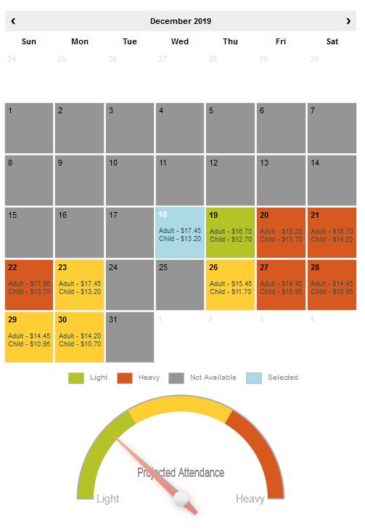
What does it cost to buy an airline ticket, book a rideshare service, or make a hotel reservation? Nowadays the answer to that question may vary minute-to-minute, as companies use data analysis and clever algorithms to calibrate their pricing to demand. Disney recently introduced such variable pricing for its theme parks, pricing tickets on a sliding scale based on ‘value’, ‘regular,’ and ‘peak’ dates. Museums are beginning to follow suit, using historic attendance data to forecast demand, and set pricing accordingly. This practice can help provide affordable options to visitors, while ensuring the museum isn’t leaving money on the table by selling tickets for less than people are willing and able to pay.
Today’s post explores how two museums implemented dynamic pricing, based on interviews with Lisa Townsend, vice president of marketing and external relations at The Children’s Museum of Indianapolis, and Dennis Woerner, director of marketing at the Indianapolis Zoo.
–Elizabeth Merritt, VP Strategic Foresight and Founding Director, Center for the Future of Museums
Elizabeth Merritt (EM): When did you adopt variable pricing, and what was your motivation?
Lisa Townsend (LT): We adopted variable pricing in 2017, prompted by the fact that non-member paid attendance had been declining a little bit for several years. We had been instituting price increases of about $1 a year, and hypothesized that we had priced ourselves out of reach of some people. When we dug into the data, we found that the demographic we were losing most rapidly was lower-middle-income—households earning $35k-$60k/year. People in that group do not qualify for our Access Pass (which is $2/person), and the museum was concerned about losing them.
Dennis Woerner (DW): We instituted this system in 2014, by which time it was already in common use in sports, concerts, etc. We were the second zoo in the world to adopt dynamic pricing, and the first in the Western Hemisphere. At least four other zoos have picked up on it since. Our motivation was to improve guest satisfaction. We were about to open a new Orangutan Center, and knew we would overcrowd the zoo on weekends, Memorial Day through Labor Day. At our zoo, ten thousand visitors on one day is a huge crowd—and we expected it to now reach fifteen thousand on peak days! We wanted to implement a pricing strategy that moved some visitors onto weekdays or into our shoulder season.
EM: How does your pricing system work?

DW: We bid the contract out to three groups, and chose Digonex, an Indianapolis-based company with sports expertise. The economists on their team took five years of data from the zoo—attendance by day, weather, etc.—and fed it into an algorithm that recommends pricing for each day we are open. We use plan-ahead pricing, and show the projected attendance for any given day on the web as a dial.
Our ticket price had been $17.50—the new system offers prices from a low of $8 on weekdays in January and February to a high of $29.95 for Saturdays in late June. These starting prices are posted on the website, and they go up as it gets closer in time to the actual date—reaching $1 to $2 higher per person on the day itself. The price only goes up, never down, and the price is always lower if you buy online. If it is raining on the day they planned to visit, purchasers can change the date of visit for their tickets, but they have to pay any price differential. We update the prices once a year based on rolling five-year data.
We still offer free admission on MLK day to anyone coming with a canned good contribution. We also offer a “Go” membership priced at $25 for income-challenged families, if they show proof of income.
LT: What we have instituted is not true dynamic pricing (which can go up or down in response to demand). Like the [Indianapolis] Zoo, we use a variation called “buy ahead” pricing, in which the further ahead someone buys tickets, the more money they can save. If visitors are willing to purchase in advance, they know they can save money. Our pricing factors in projected demand, using all available data—school calendars, museum exhibit plans, holidays, marketing spending by the museum, etc. Digonex does the data analysis and recommends the optimal pricing. Every day at 4 p.m. an automated email from Digonex gives us new recommended prices for the following week. Staff can approve these recommendations or make changes. At midnight the new prices upload to our website, ticketing software, and box office price boards. Staff have developed a lot of faith in the system. We’ve learned we come out where we need to be by following these recommendations.
One question we get is, “What happens if the kids get sick and the family can’t come?” We don’t give refunds but we do have an exchange policy.
EM: What’s been the outcome of implementing these pricing systems?
LT: It is hard to know for sure whether the dynamic pricing is helping to bring in lower-middle-income demographics in response to the pricing. We sent a survey to people who bought tickets online, asking three questions:
- Have you been to the museum before?
- When was the last time you visited?
- What is your household income?
We can see that we are attracting people who have never been before, or have not visited in many years, from the middle-income demographic, but attendance from this group is still not as strong as we would like it to be. Financially the system is a success—with our per caps exceeding our goal numbers by about 35 cents per person so far this year.
We found that when it comes to public reaction, it’s all about listening to what our visitors want and then positioning it in the right way. The Children’s Museum has had remarkably little negative feedback, probably because we did a lot of research and focus group work ahead of time, which helped inform our messaging. When we rolled out the program, we talked about the benefits of the pricing model and people understood. It is a good way of serving people who have less disposable income and are looking for bargains.
Overall, we have been very pleased with how the system lets us continuously test the market. In the traditional pricing model, you typically post one price per year and see what happens. With this system of pricing you can run an experiment every day. It takes into account how many people purchased a ticket today for some point in the future.
DW: We implemented dynamic pricing in the spring and moved 10 percent of attendance off of busy weekends and holidays. Some research we have done suggests that lower-income individuals are more likely to buy at the lower rates, while other people are just shopping for bargains. Overall, we didn’t see any big change in the demographics of our visitors.
The system has driven more revenue, and it did change the value of membership, making it look like an even better deal. If you visit twice in a year, membership is a good value. So membership rocketed—it used to be half of total attendance, now it is 58 percent.
EM: Do you have any advice for museums considering adopting variable pricing?
DW: Each museum or attraction should review their current business situation—is there a new exhibit that will drive excess demand in terms of attendance, what are my revenue goals, what can my facility hold in terms of attendance daily and even hourly? Are you currently overpriced, or underpriced, how does membership factor into your attendance along with group attendance from the school, youth, church, and corporate sectors?
If you have a concern about overcrowding or feel that you are not maximizing your revenue potential, then you should consider dynamic pricing. Dynamic pricing can be as radical as pricing hourly (like gas stations) or daily (the [Indianapolis] Zoo, concerts, sports). Or it could be more conservative using more of a variable pricing model, with prices that vary seasonally at certain times of the year when demand is higher or lower.
Ultimately, dynamic pricing allows you much more control of your revenue options than a static priced model. Dynamic pricing allows you to reach price-sensitive consumers and it also allows you to maximize revenue for those who are more concerned about time constraints and are not impacted as much by price. Dynamic pricing also allows you to impact the flow of visitors on certain days, making your staffing models much more budget efficient.








